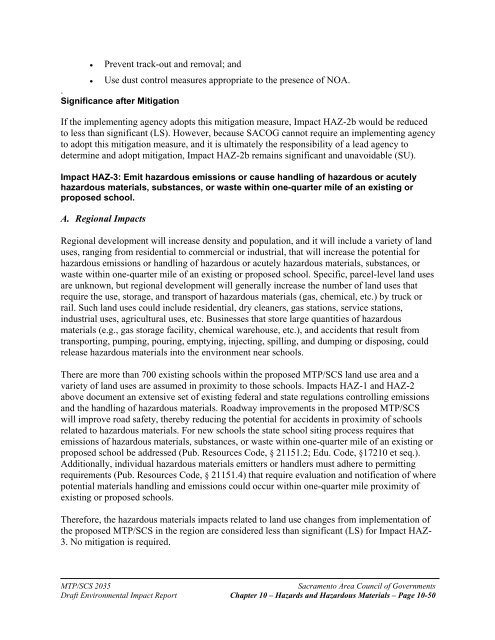CHAPTER 10 – HAZARDS AND HAZARDOUS MATERIALS - sacog
CHAPTER 10 – HAZARDS AND HAZARDOUS MATERIALS - sacog
CHAPTER 10 – HAZARDS AND HAZARDOUS MATERIALS - sacog
You also want an ePaper? Increase the reach of your titles
YUMPU automatically turns print PDFs into web optimized ePapers that Google loves.
Prevent track-out and removal; and<br />
Use dust control measures appropriate to the presence of NOA.<br />
.<br />
Significance after Mitigation<br />
If the implementing agency adopts this mitigation measure, Impact HAZ-2b would be reduced<br />
to less than significant (LS). However, because SACOG cannot require an implementing agency<br />
to adopt this mitigation measure, and it is ultimately the responsibility of a lead agency to<br />
determine and adopt mitigation, Impact HAZ-2b remains significant and unavoidable (SU).<br />
Impact HAZ-3: Emit hazardous emissions or cause handling of hazardous or acutely<br />
hazardous materials, substances, or waste within one-quarter mile of an existing or<br />
proposed school.<br />
A. Regional Impacts<br />
Regional development will increase density and population, and it will include a variety of land<br />
uses, ranging from residential to commercial or industrial, that will increase the potential for<br />
hazardous emissions or handling of hazardous or acutely hazardous materials, substances, or<br />
waste within one-quarter mile of an existing or proposed school. Specific, parcel-level land uses<br />
are unknown, but regional development will generally increase the number of land uses that<br />
require the use, storage, and transport of hazardous materials (gas, chemical, etc.) by truck or<br />
rail. Such land uses could include residential, dry cleaners, gas stations, service stations,<br />
industrial uses, agricultural uses, etc. Businesses that store large quantities of hazardous<br />
materials (e.g., gas storage facility, chemical warehouse, etc.), and accidents that result from<br />
transporting, pumping, pouring, emptying, injecting, spilling, and dumping or disposing, could<br />
release hazardous materials into the environment near schools.<br />
There are more than 700 existing schools within the proposed MTP/SCS land use area and a<br />
variety of land uses are assumed in proximity to those schools. Impacts HAZ-1 and HAZ-2<br />
above document an extensive set of existing federal and state regulations controlling emissions<br />
and the handling of hazardous materials. Roadway improvements in the proposed MTP/SCS<br />
will improve road safety, thereby reducing the potential for accidents in proximity of schools<br />
related to hazardous materials. For new schools the state school siting process requires that<br />
emissions of hazardous materials, substances, or waste within one-quarter mile of an existing or<br />
proposed school be addressed (Pub. Resources Code, § 21151.2; Edu. Code, §172<strong>10</strong> et seq.).<br />
Additionally, individual hazardous materials emitters or handlers must adhere to permitting<br />
requirements (Pub. Resources Code, § 21151.4) that require evaluation and notification of where<br />
potential materials handling and emissions could occur within one-quarter mile proximity of<br />
existing or proposed schools.<br />
Therefore, the hazardous materials impacts related to land use changes from implementation of<br />
the proposed MTP/SCS in the region are considered less than significant (LS) for Impact HAZ-<br />
3. No mitigation is required.<br />
MTP/SCS 2035<br />
Sacramento Area Council of Governments<br />
Draft Environmental Impact Report Chapter <strong>10</strong> <strong>–</strong> Hazards and Hazardous Materials <strong>–</strong> Page <strong>10</strong>-50
















